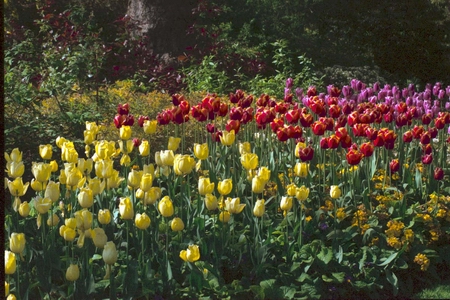Tulips, the Secret to Spring Colour
By Jos Van Hage

A flower that is recognized the world over is the tulip.
Originating in Turkey, tulip means turban in Turkish which aptly describes this spring flowering bulb. Although it originated in Turkey, the tulip was introduced to Holland in the early 1600’s and since then has always been considered part of the Dutch culture.
There are over 2000 different varieties that have been divided into 15 different categories. The categories are decided on bloom times and growth habits.
The earliest blooming categories are the ’Fosteriana’, ’Kaufmanniana’, and ’Greigii’, types. Fosteriana types have large single
flowers, broad foliage, and grow 12-14 inches tall. The Kaufmanniana types grow 8-10 inches, with bi-colored flowers that look similar to water lilies and the foliage is either striped or mottled. The Greigii types also have striped or mottled low growing foliage with large showy flowers that grow 10-12 inches tall. These are all excellent for borders or rock gardens including the ’Species’ types which have varieties that grow only 4-8 inches tall. The Species types are a mid season bloomer.
The next in line to bloom are the ’Single Early’ types and the ’Double Early’ types which grow 10-12 inches tall. The single early varieties have a large, single flower with pointed petals. The double early varieties are very pretty with flowers that look peonies. Types that bloom mid-season are ’Darwin’and ’Triumph’. Varieties found in the Darwin group tend to make good cut flowers as the stems are very sturdy and grow 20-24 inches tall. The Triumph varieties are a cross between the single early and the late types and have the traditional large shaped flowers on strong, sturdy stems making them also ideal for cut flowers.
The last to bloom would be the ’Single Late’ and the ’Double or Peony Late’ varieties. Other categories are the ’Lily flowered’ which grow 20-24 inches tall and have a very slim elegant flower which has pointed tips. ’Fringed’ varieties are identified by their flowers which have a fringed or ruffled edges and look somewhat like an orchid. ’Parrot’ types have flower petals that are large and twisted and come in different color combinations making them look like feathers. The ’Viridiflora or Green’ type have varieties that have single lily shaped flowers which have some green on them and the ’Rembrandt’ types are similar to the Darwin varieties with the difference being that the Rembrandt varieties all have streaked or variegated flowers that are usually red, white or yellow.
Tulips are easy to grow as they contain all the needed nutrients in the bulb. As I said last week, choose large bulbs because the larger the bulb the larger the flower.
At the risk of repeating myself (we talked about bulbs last week) here are the tips you need to know to make your tulip show spectacular.
Plant tulips in a well drained soil preferably sandy loam. Plant bulbs at a depth of 4-5 inches and space them 3-5 inches apart. For best results always mix a handful of bone meal with the soil at the bottom of the hole before placing the bulbs in the hole. You want to plant a minimum of 8-10 bulbs in a clump for nicest looking show in the spring.
After the bulbs have been planted water them in well. You want to plant the bulbs in early Fall so that the bulbs can get a good root system established before the winter sets in. In the spring after the bulb has finished blooming remove the finished flower leaving the stem and foliage. You want to remove the flower before it forms a seed pod which would take away important nutrients from the bulb. The stem and foliage need to die back naturally as this is when the bulb is forming next years flower in the bulb.
After 3-4 years you will notice that the flowers are not as big as they first were and this is when you would dig up the bulbs in early August. After digging up the bulbs you need to separate them and throw out the small bulbs while keeping the larger sized bulbs which are stored in a cool, dry space for a few weeks before replanting them again in early September.
Bulbs are a good investment for the garden as they will continue to bloom for many years to come if looked after properly.
-Jos.
Jos Van Hage owns and operates two Ar Knapp Garden Centres in the Prince George region:
Highway 16 West in COllege Heights
Highway 97 North at Aberdeen Road
Previous Story - Next Story
Return to Home








